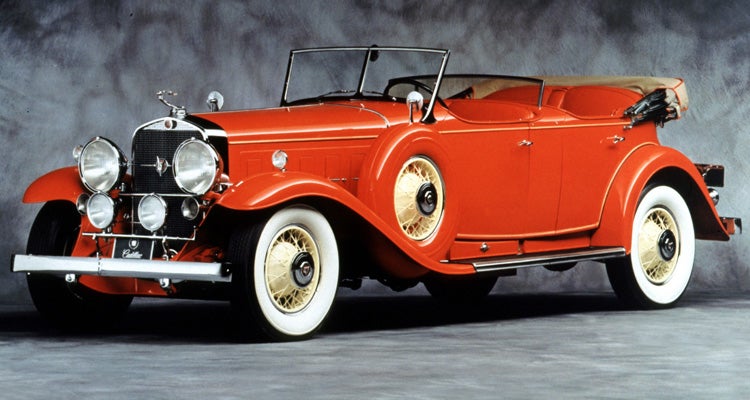Cadillac V-16
Rolls-Royce may have coined the slogan, but for <i><b>Brian Sewell </b></i>the Thirties Cadillac is still the best

It is mischievous, in the month we celebrate the centenary of Rolls-Royce, to murmur the words Cadillac and V-16, but I am unrepentant. Rolls-Royce, it seems, became acknowledged as "The Best Car in the World" for no better reason than that Rolls the entrepreneur, Royce the engineer and everyone connected with the firm used this as their advertising slogan.
It is mischievous, in the month we celebrate the centenary of Rolls-Royce, to murmur the words Cadillac and V-16, but I am unrepentant. Rolls-Royce, it seems, became acknowledged as "The Best Car in the World" for no better reason than that Rolls the entrepreneur, Royce the engineer and everyone connected with the firm used this as their advertising slogan.
If, when Rolls got into its stride with the Silver Ghost, it had claimed it to be the world's most scrupulously constructed oar, with every nut and bolt designed by Rolls and turned by craftsmen's hands, with every constituent of engine and transmission built to withstand forces far greater than would ever come into play, I'd not quarrel with the claim - but "best" must surely take design and technology into account at least as much as care in manufacture.
The engine of the 1906 Silver Ghost was a straight six-cylinder of 7,036cc. In 1925, in the Phantom I, it was replaced by another, of 7,668cc. In 1929, this second engine was retained in the Phantom II and remained in production until 1935, when the Phantom III appeared, at last with a V-12 engine of 7,340cc in response to V-12a by Daimler, Hispano-Suiza, Packard and Lincoln, and to V-16s made first by Cadillac and Marmon.
Now, if ever the Rolls had been the best car in the world, it could not still have been so in the decade of the straight six Phantom engine, a retrograde design of long stroke and narrow bore compared with the "square'' engine of the Ghost.
In 1916, Cadillac had been the first manufacturer to make a V-8 engine the standard power unit. When it became common, its rivals, Packard and Lincoln, produced their V-12s; in 1930, in the middle of the Phantom's decade, Cadillac leapfrogged the lot with a V-16.
Of 7,420cc, its 16 cylinders were in two iron blocks at the narrow angle of 45 degrees, mated to an aluminium alloy crankcase. This overhead-valve masterpiece, whisper quiet, developed 165bhp - significantly more than the 100bhp of the Rolls in 1925 and the 120bhp in 1929 - and with 320 foot pounds of torque it was aimed at turbine-smooth delivery of power rather than brute acceleration.
So proud was Cadillac of this engine, the refinement of which was equalled by no other manufacturer, that everything under the bonnet that could be plated and polished was so; it looked like an engine, but one over which the designer of Tilly Losch's Art Deco bathroom had waved his stylist's wand.
Cadillac had been part of General Motors since 1909, but had pursued an independent role. In 1925, GM bought the Fleetwood Metal Body Co, coachbuilders to Rockefellers, Carnegies and Vanderbilts (and Rudolf Valentino); in 1926, it took on Harley Earl (1893-1969), the most important man in the history of American car design (the finned Cadillacs of the Fifties were his); and in 1930 they put them together to clad the Cadillac V-16s.
Earl's imagination lent the necessary classicism of this market a distinctly rakish air. Fleetwood translated the improbable into the possible and offered no fewer than 54 "catalogue custom'' bodies that could be tweaked to please every purchaser - Al Capone, for example, specified gun cabinets on his. To put exactly the Mulliner body that one wanted onto a Rolls chassis might take a year, but to put its Fleetwood equal on to a Cadillac took only a week or two.
Were they any less rare and individual? To put this matter into perspective, the total production of the V-16 chassis between 1930 and 1937 was 4,403, with 54 possible bodies (and a few more from Paris); the total production of Phantoms with six-cylinder engines was 3,893, and 55 was the number of British coachbuilders recorded (again, some were bodied in Europe, even by Sodomka in Czechoslovakia).
Seventy years on, the Cadillac is probably the rarer beast. They were friendlier to the owner-driver. With three-speed all-synchromesh gearboxes, there was none of the crashing, double-declutching, mis-meshing business of the Rolls - besides starting in top was perfectly possible. Braking was servo-assisted, so slowing three-ton behemoths was easy. The sportier bodies could reach the magic ton.
The very rich bought 2,887 V-16s in its first year; sales dropped to 364 in 1931 and it took until 1940 to sell another 1,152; the Great Depression cannot have helped sales of a car that was both expensive and virtually indestructible, with Cadillac offering a level of service that matched that of Rolls-Royce.
This great car was eventually replaced by another V-16, the 1938 Series 90, with which it must never be confused. It had a side-valve engine, an unsophisticated lump. It appealed to the Pope, Salvador Dali, the Duke of Windsor and 512 other customers. It was the last series-production V-16 made, but it had no cachet. The classic Cadillac V-16 can only be the Art Deco beauty of the early Thirties - briefly, it gave Cadillac the right to claim that it made "The Best Car in the World".
Subscribe to Independent Premium to bookmark this article
Want to bookmark your favourite articles and stories to read or reference later? Start your Independent Premium subscription today.

Join our commenting forum
Join thought-provoking conversations, follow other Independent readers and see their replies